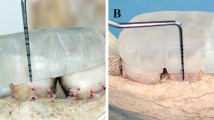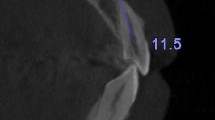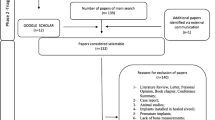Abstract
Objective
This study sought to compare the thickness of hard and soft tissues between edentulous and contralateral tooth sites.
Materials and Methods
This split-mouth study evaluated 153 partially edentulous patients. The measurements were made on cone-beam computed tomography (CBCT) scans. The soft tissue thickness was measured at the cementoenamel junctional (CEJ) level, and at 2, 4, and 6 mm apical to the CEJ in the facial and palatal aspects. The bone thickness of the opposite quadrant was also recorded at 2, 4, and 6 mm apical to the CEJ. The Mann–Whitney U test and the Spearman's rank correlation coefficient were applied for further statistical analyses.
Results
At the edentulous sites, significant soft tissue loss was noted at the CEJ level (p < 0.0001) and a considerable gain was noted at 2, 4, and 6 mm apical to the CEJ (p = 0.004, p < 0.0001, p ≤ 0.0001, respectively). A significant hard tissue loss was noted at 2 mm apical to the CEJ but a significant hard tissue gain was observed at the edentulous sites (p < 0.0001). The soft tissue gain at 6 mm apical to the CEJ was significantly associated with an increase in buccolingual diameter (p = 0.004) while the hard tissue loss at 2 mm apical to the CEJ was significantly correlated with a reduction in buccolingual diameter (p = 0.020)
Conclusion
Different amounts of tissue thickness alterations occurred in different levels of socket.





Similar content being viewed by others
References
Marton R, Martin A, Lemperger S, Windisch P (2017) Treating tissue defects following tooth removal. Three case reports. Orv Hetil 158(31): 1228–1234
Araujo MG, Silva CO, Misawa M, Sukekava F (2015) Alveolar socket healing: what can we learn? Periodontol 2000 68(1): 122–134
Chen ST, Buser D (2009) Clinical and esthetic outcomes of implants placed in postextraction sites. Int J Oral Maxillofac Implants 24:186–217
O’Brien TP, Hinrichs JE, Schaffer EM (1994) The prevention of localized ridge deformities using guided tissue regeneration. J Periodontol 65(1):17–24
Lekovic V, Camargo PM, Klokkevold PR, Weinlaender M, Kenney EB, Dimitrijevic B, Nedic M (1998) Preservation of alveolar bone in extraction sockets using bioabsorbable membranes. J Periodontol 69(9): 1044–1049
Afrashtehfar, K. I., Kurtzman, G. M., & Mahesh, L. Improving oral rehabilitation through the preservation of the tissues through alveolar preservation: J Adv Prosthodont. 2012 Aug;4(3):174–8. doi: https://doi.org/10.4047/jap.2012.4.3.174. Epub 2012 Aug 28.
Hammerle CH, Jung RE, Yaman D, Lang NP (2008) Ridge augmentation by applying bioresorbable membranes and deproteinized bovine bone mineral: a report of twelve consecutive cases. Research Support, Non-U S Gov't. Clin Oral Implants Res 19(1): 19–25
Iasella JM, Greenwell H, Miller RL, Hill M, Drisko C, Bohra AA, Scheetz JP (2003) Ridge preservation with freeze-dried bone allograft and a collagen membrane compared to extraction alone for implant site development: a clinical and histologic study in humans. J Periodontol 74(7):990–999
Jung RE, Philipp A, Annen BM, Signorelli L, Thoma DS, Hammerle CH, Attin T, Schmidlin P (2013) Radiographic evaluation of different techniques for ridge preservation after tooth extraction: a randomized controlled clinical trial. J Clin Periodontol 40(1):90–98
Crespi R, Cappare P, Gastaldi G, Gherlone E (2016) Reactive soft tissue preservation in large bone defects after tooth extractions: a cone beam study. Int J Oral Maxillofac Implants 31(1):179–185
Chappuis V, Engel O, Shahim K, Reyes M, Katsaros C, Buser D (2015) Soft tissue alterations in esthetic postextraction sites: a 3-dimensional analysis. J Dent Res 94(9 Suppl):30
Gurtner GC, Werner S, Barrandon Y, Longaker MT (2008) Wound repair and regeneration. Nature 453(7193):314–321
Klingberg F, Hinz B, White ES (2013) The myofibroblast matrix: implications for tissue repair and fibrosis. J Pathol 229(2):298–309
Farmer M, Darby I (2014) Ridge dimensional changes following single-tooth extraction in the aesthetic zone. Clin Oral Implants Res 25(2):272–277
Johnson K (1969) A study of the dimensional changes occurring in the maxilla following tooth extraction. Aust Dent J 14(4):241–244
Araujo MG, Lindhe J (2005) Dimensional ridge alterations following tooth extraction. An experimental study in the dog. J Clin Periodontol 32(2): 212–218
Ten Heggeler JM, Slot DE, Van der Weijden GA (2011) Effect of socket preservation therapies following tooth extraction in non-molar regions in humans: a systematic review. Clin Oral Implants Res 22(8):779–788
Misawa M, Lindhe J, Araujo MG (2016) The alveolar process following single-tooth extraction: a study of maxillary incisor and premolar sites in man. Clin Oral Implants Res 27(7):884–889
Braut V, Bornstein MM, Belser U, Buser D (2011) Thickness of the anterior maxillary facial bone wall-a retrospective radiographic study using cone beam computed tomography. Int J Periodontics Restorative Dent 31(2):125–131
Chappuis V, Engel O, Reyes M, Shahim K, Nolte LP, Buser D (2013) Ridge alterations post-extraction in the esthetic zone: a 3D analysis with CBCT. J Dent Res 92(12 Suppl):24
Belgin CA, Adiguzel O, Bud M, Colak M, Akkus Z (2017) Mandibular buccal bone thickness in Southeastern Anatolian people: a cone-beam computed tomography study. Int Dental Res 7(1):6–12
Karadede İ, Adigüzel Ö, Özer T, Bilgiç F, İzol RÖ (2012) Virtual modeling of a cleft lip and palate patient. Int Dental Res 2(2): 43-47
Ludlow JB, Ivanovic M (2008) Comparative dosimetry of dental CBCT devices and 64-slice CT for oral and maxillofacial radiology. Oral Surg Oral Med Oral Pathol Oral Radiol Endodontol 106(1):106–114
Ahmad M, Jenny J, Downie M (2012) Application of cone beam computed tomography in oral and maxillofacial surgery. Aust Dent J 57:82–94
Acknowledgements
Authors kindly appreciate Dr. Mahshid Namdari for statistical analysis of the data.
Funding
The present study did not receive any particular grant from commercial, public, or not-for-profit funding agencies.
Author information
Authors and Affiliations
Contributions
RA and YS involved in study design; BB participated in data collection; MN involved in data analysis; MK participated in manuscript preparation.
Corresponding author
Ethics declarations
Conflict of interest
The authors declare that they have no conflict of interest to this study.
Ethics approval
All procedures followed were in accordance with the ethical standards of the responsible committee on human experimentation (Ethics committee of the Dental School of Shahid Beheshti University of Medical Sciences, Iran (IR.SBMU.RIDS.REC.1395.400)). and with the Helsinki Declaration of 1975, as revised in 2008. Informed consent was obtained from all patients for being included in the study.
Informed consent
Written informed consent was obtained from all patients to use their diagnostic radiographs in this research. It was explained that their identifying information would only be accessible to the researchers and would not be included in the article.
Additional information
Publisher's Note
Springer Nature remains neutral with regard to jurisdictional claims in published maps and institutional affiliations.
Rights and permissions
About this article
Cite this article
Safi, Y., Behnam, B., Amid, R. et al. Soft and Hard Tissue Changes Subsequent to Spontaneous Healing of the Extraction Sockets Using Cone-Beam Computed Tomography: A Cross-Sectional Study. J. Maxillofac. Oral Surg. 21, 1168–1174 (2022). https://doi.org/10.1007/s12663-021-01651-9
Received:
Accepted:
Published:
Issue Date:
DOI: https://doi.org/10.1007/s12663-021-01651-9




